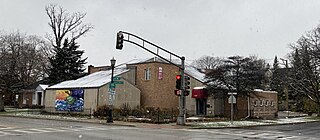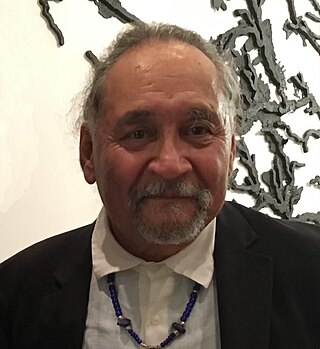Related Research Articles

The Ojibwe are an Anishinaabe people whose homeland covers much of the Great Lakes region and the northern plains, extending into the subarctic and throughout the northeastern woodlands. Ojibweg, being Indigenous peoples of the Northeastern Woodlands and of the subarctic, are known by several names, including Ojibway or Chippewa. As a large ethnic group, several distinct nations also understand themselves to be Ojibwe as well, including the Saulteaux, Nipissings, and Oji-Cree.

Quillwork is a form of textile embellishment traditionally practiced by Indigenous peoples of North America that employs the quills of porcupines as an aesthetic element. Quills from bird feathers were also occasionally used in quillwork.

Birch bark or birchbark is the bark of several Eurasian and North American birch trees of the genus Betula.

The Mitchell Museum of the American Indian is a museum in Evanston, Illinois that focuses exclusively on the history, culture and arts of North American native peoples. It is a Core Member of the Chicago Cultural Alliance, a consortium of 25 ethnic museums and cultural centres in Chicago.

A wiigwaasabak is a birch bark scroll, on which the Ojibwa (Anishinaabe) people of North America wrote with a written language composed of complex geometrical patterns and shapes.

The Forest County Potawatomi Community is a federally recognized tribe of Potawatomi people with approximately 1,400 members as of 2010. The community is based on the Forest County Potawatomi Indian Reservation, which consists of numerous non-contiguous plots of land in southern Forest County and northern Oconto County, Wisconsin, United States. The community also administers about 7 acres (28,000 m2) of off-reservation trust land in the city of Milwaukee. According to the U.S. Census Bureau, the reservation and off-reservation trust land together have a total area of 22.72 square miles (58.8 km2). The combined population of Forest County Potawatomi Community and Off-Reservation Trust Land was 594 in the 2020 census. The nation's administrative and cultural center are located about three miles east of Crandon, Wisconsin.
Maude Kegg was an Ojibwa writer, folk artist, and cultural interpreter. She was a member of the Mille Lacs Band of Ojibwe, located in east-central Minnesota.
Birchbark biting is an Indigenous artform made by Anishinaabeg, including Ojibwe people, Potawatomi, and Odawa, as well as Cree and other Algonquian peoples of the Subarctic and Great Lakes regions of Canada and the United States. Artists bite on small pieces of folded birch bark to form intricate designs.
Jim Northrup was an Anishinaabe newspaper columnist, poet, performer, and political commentator from the Fond du Lac Indian Reservation in Minnesota. His Anishinaabe name was "Chibenashi".
Woodlands style, also called the Woodlands school, Legend painting, Medicine painting, and Anishnabe painting, is a genre of painting among First Nations and Native American artists from the Great Lakes area, including northern Ontario and southwestern Manitoba. The majority of the Woodland artists belong to the Anishinaabeg, notably the Ojibwe, Odawa, and Potawatomi, as well as the Oji-Cree and the Cree.

Kelly Jean Church is a black ash basket maker, Woodlands style painter, birchbark biter, and educator.

The Mille Lacs Indian Museum and Trading Post is a museum dedicated to the Mille Lacs Band of Ojibwe's history, culture, and contemporary life. It officially opened to the public on May 18, 1996. Located in Onamia, Minnesota, United States, it is one of the 26 historical sites and museums run by the Minnesota Historical Society.

Jim Denomie was an Ojibwe Native American painter, known for his colorful, at times comical, looks at United States history and Indigenous peoples of the Americas.

A wiigwaasi-makak, meaning "birch-bark box" in the Anishinaabe language, is a box made of panels of birchbark sewn together with watap. The construction of makakoon from birchbark was an essential element in the culture of the Anishinaabe people and other members of the Native Americans and First Nations of the Upper Great Lakes, particularly in the regions surrounding Lake Superior. Birchbark makakoon continue to be crafted to this day as heritage heirlooms and for the tourist trade.
Andrea Carlson is a mixed-media American visual artist currently based in Chicago. She also maintains a studio space and has a strong artistic presence in Minneapolis–Saint Paul, Minnesota.
Dyani White Hawk is a contemporary artist and curator of Sicangu Lakota, German, and Welsh ancestry based out of Minnesota. From 2010 to 2015, White Hawk was a curator for the Minneapolis gallery All My Relations. As an artist, White Hawk's work aesthetic is characterized by a combination of modern abstract painting and traditional Lakota art. White Hawk's pieces reflect both her Western, American upbringing and her indigenous ancestors mediums and modes for creating visual art.
Yvonne Walker Keshick is an Anishinaabe quillwork artist and basket maker.
David Moses Bridges was a Native American environmentalist and artist known for his traditional birchbark canoes and baskets. He was a member of the Passamaquoddy tribal community on the Passamaquoddy Pleasant Point Reservation. Bridges fought for tribal environmental rights and was a co-founder of Mulankeyutmonen Nkihtakmikon, to preserve the Wabanaki culture.

Cherish Nebeshanze Parrish is a black ash basket maker and birchbark biter. She is a member of the Match-e-be-nash-she-wish Band of Pottawatomi Indians of Michigan and of Odawa descent.

Tomah Joseph, a.k.a.Joseph Tomah and Tomah Josephs, was a Passamaquoddy artist and governor of communities in Maine in the United States. He taught the future US president Franklin Delano Roosevelt how to canoe.
References
- 1 2 Office, CPN Public Information (2018-01-22). "Birchbark art: then and now: Ojibwe artist Pat Kruse learns, teaches traditional ways • Citizen Potawatomi Nation". Citizen Potawatomi Nation. Retrieved 2020-02-18.
- ↑ "Bockley Gallery :: Artists :: Pat and Gage Kruse". bockleygallery.com. Retrieved 2020-02-18.
- 1 2 Cales, Laura (2018-04-17). "Patrick William Kruse". Native Arts and Cultures Foundation. Retrieved 2020-03-03.
- ↑ Drankhan, Holly (2015-06-25). "Birch bark canoe artists keep Native American tradition afloat". Great Lakes Echo. Retrieved 2020-03-03.
- ↑ Office, CPN Public Information (2018-01-22). "Birchbark art: then and now: Ojibwe artist Pat Kruse learns, teaches traditional ways • Citizen Potawatomi Nation". Citizen Potawatomi Nation. Retrieved 2020-03-03.
- ↑ Drankhan, Holly (2015-06-25). "Birch bark canoe artists keep Native American tradition afloat". Great Lakes Echo. Retrieved 2020-03-03.
- 1 2 "Minnesota Birch Bark Artist Pat Kruse Donates Mural to Children's Hospitals and Clinics of Minnesota". Minnesota Historical Society. Retrieved 2020-02-18.
- 1 2 "Exhibitions: Pat & Gage Kruse and Jim Proctor". Bockley Gallery. Retrieved 2020-03-03.
- ↑ "All Races' Bouquet #6". art.nelson-atkins.org. Retrieved 2020-02-18.
- ↑ Rupert (2015-10-21). "Pat Kruse". Native Arts and Cultures Foundation. Retrieved 2020-02-18.
- ↑ "Plains Art Museum Annual Report" (PDF). June 30, 2016.
{{cite journal}}: Cite journal requires|journal=(help) - ↑ "Tweed Museum of Art". www.d.umn.edu. Retrieved 2020-03-03.
- ↑ Kruse, Patrick and Gage. "Bockley Gallery" (PDF). Bockley Gallery. Retrieved March 3, 2020.
- ↑ "Pat and Gage Kruse Father and Son, b. 1971 and 1995" (PDF). www.bockleygallery.com.
- ↑ "ARTIST FELLOWSHIPS". Native Arts and Cultures Foundation. Retrieved 2020-03-03.